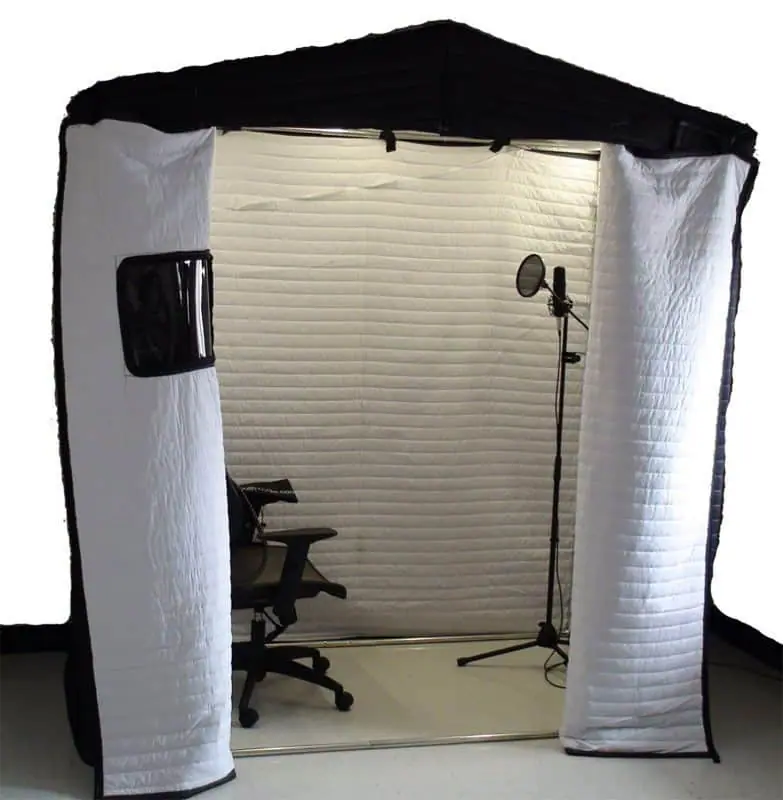What are Vocal Booths you say? Well, they are also known as Isolation booths or sound booths. These booths serve two purposes. Firstly they isolate the vocalist from the band and any other outside noises so that you may record vocals without any noise leakage. They absorb sound so that they do not colour the sound by adding echo, reverb etc.
Secondly, they are used as practice booths where you can theoretically sing and play without disturbing your neighbours, family, friends or pets.
I live in an apartment and need to be able to sing without disturbing anyone. What are the solutions?
You can try your hand at building your own or you can buy prefab kits that require assembly. You may want to read about studio design to get a better idea of how sound isolation works. You basically have to build a room within a room where there is no (or little ) physical contact between each room. You might get away by modifying a closet. You could even try singing in an existing clothes closet.
I also suggest you check out “Green Glue” and read about this amazing product.
Here are the prime Vocal Booth manufacturers.
The Isovox idea is similar to an idea I’ve had in the back of my head for some time now. I call my idea the “Dome of Silence”, not quite the “Get Smart” one but basically a box that would allow me to sing at night in my apartment. Does it work? I don’t know. There are some demos on YouTube that demonstrate the isolation that can be achieved. Most of the demo videos I have seen recently leave a lot to be desired.
If you know anyone using one, try to arrange a demo. Few of these manufacturers featured on this page show any demos featuring my type of situation.
Here are some links
https://www.lavocalbooths.com/lawhisperroom
“Vocal Booths To Go” uses heavy blankets over a tubular frame thus making it easy to move.
Studiobox is yet another Vocal booth manufacturer based in Germany. The English version of this site is down ( aug 11-22)
Snap Studio makes a portable sound absorbing booth, not soundproof. this is basically moving blankets over a PVC frame.
Bear Cave Silent Booths This Canadian company seems to be a new player
LA Vocal Booths a new company specializing in big-box type booths.
Once you see the cost of these prefab boxes you may want to go the DIY route. One question I have is how well do these boxes work. Try to find someone who has one.
There are also quite a few DIY sites where you can find suggestions on what you need to design your own.
Check these out
Here we have some Vocal Booth design ideas
source: Primeacoustics
Here we have a another DIY article
This time, the team converts a small empty room into a professional vocal booth within the space of a single afternoon!
Source:Source: Recording magazine article on DIY booth
sound control room easy-to-build-vocal-booth.php
He’s a DIY Vocal Booth built in a garage. DIY vocal booth in a garage.
Below is yet another interesting article on DIY vocal booths.
The world of home recording is hard. But it doesn’t have to be expensive. Get clear, radio-ready vocals with this cheap DIY vocal booth design.
Source: The BEST DIY Vocal Booth On A Budget (STEP-BY-STEP)
This fellow uses PVC tubing as his frame.
Here is another take on the PVC blanket booth with blueprint plans.
Another DIY sound booth
Another take on a DIY sound booth
Here is an idea for a more elaborate booth.
DAWBOX can sell you detailed plans to build your own booth.
There are now quite a few videos on YouTube showing DIY solutions.
The same isolation concepts applies to Computers and Amps.
Both these generate lots of heat. Again there are ready-made boxes available and plans for the DIY’er.
These boxes weigh a ton so shipping is a big concern. Occasionally you might find a used one in Craig’s list.
If you are going the DIY route check out so acoustic absorption products.
CANADIAN BUYERS BEWARE
There are countless DIY projects that one can build using PVC pipes. Unfortunately, Canadians pay about 3 times the US price. It took me several years to find out why. A 10′ sched. 40 3/4″ PVC sell for $2.71 US in the USA. The same pipe is $10.98 Canadian. Using the current exchange rate of 0.75 that becomes $3.61 Canadian. In Canada, we have to add up to 15% taxes to that $10.98 price making it $12.67. That is more than 3 times the US price. Since I live near the border it would be cheaper for me to drive to the US buy a lot of pipes, pay duties, lunch, gas and still come out a winner. The reason is that Canadian PVC is mostly CSA approved. This is a process that costs a lot to implement, inspections, and mounds of paperwork.

















